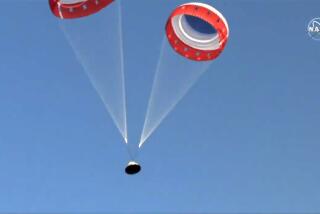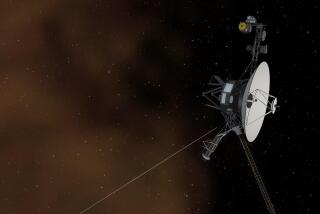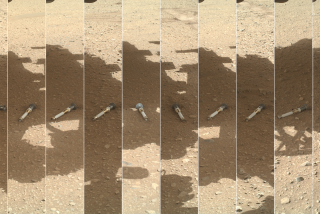NASA Unable to Establish Contact With Mars Lander
Anxious space engineers strained Friday for any signal from an errant spacecraft on Mars, hopeful that it had landed safely near the Martian south pole but fearful that they may have lost their second mission to the Red Planet since September.
Despite repeated attempts, flight operations engineers at Jet Propulsion Laboratory in Pasadena were unable to establish contact with the $165-million Mars Polar Lander, which they believe reached the Martian surface at 12:15 p.m. Friday.
Growing more glum by the hour, mission engineers late Friday also were unable to contact a $29.2-million pair of probes jettisoned from the lander as it entered the atmosphere. The armored Deep Space 2 probes were designed to slam like hypodermic needles into the Martian soil at 400 mph in a brutal field test of new technologies conceived to revolutionize planetary exploration.
NASA expected to continue trying to contact all three spacecraft throughout the weekend, with the next opportunity to reach the lander expected tonight.
High-resolution images of the lander’s touchdown site suggest that if the spacecraft did land safely, it may have done so in an area crisscrossed by ravines and potholes caused by frost heaves, which could have left the lander askew, one mission scientist said. A second mission scientist speculated that the craft may have settled off-kilter, with one of its spindly support struts stuck in a small crater. A third suggested that the surface itself may be so soft--like baby powder--that the 639-pound lander sank through into an underlying crust of ice.
“The spacecraft may just have settled in a little differently than planned,” said Dan McCleese, JPL’s chief scientist for Mars exploration.
In any of those scenarios, the craft’s medium-gain antenna that links it to Earth would be pointing in the wrong direction, preventing it from carrying out its mission. It is quite possible that the spacecraft is functioning normally but transmitting its data uselessly into space, JPL engineers said.
“I am a little bit tense at the moment, but I am still optimistic that we will hear from it,” said JPL meteorologist David Crisp, who is in charge of an advanced weather station aboard the lander. “I have worked about 10 years on those instruments. We are holding on to any chance to get this data.”
In September, the lander’s spacecraft--the $125-million Mars Climate Orbiter--disappeared as it began to orbit the planet to study weather and look for signs of water. Investigators blamed that loss on an arithmetical error: the failure to convert English-style measurements of space flight forces into the metric system.
On Friday, flight operations engineers last heard from the Mars Polar Lander three minutes after noon when the spacecraft, beginning its automated landing sequence, turned itself away from Earth as programmed so its protective heat shield was aimed toward the Red Planet.
NASA’s Deep Space Network at the Goldstone Deep Space Network station could not detect any transmission from the lander during two communications sessions Friday, but NASA officials held out hope that contact would be established with the lander sometime in the next few days. To achieve contact, mission managers are playing out a series of emergency options, based on contingency plans drawn up months before the craft ever left Earth.
So far, however, NASA has no direct evidence that the three-legged spacecraft actually survived its fiery descent.
Lander Probably Made It to Surface
As far as NASA and JPL can tell, the lander entered the Martian atmosphere at 15,400 mph, with the spacecraft’s temperatures reaching 3,000 degrees Fahrenheit because of friction with the planet’s thin shell of gases. Navigation data suggested that it may have entered the atmosphere on a slightly shallower flight path than originally planned, but it still appeared to be well within design margins.
Flight operations managers at JPL believe that the lander made it to the surface intact because the spacecraft headed into Mars with “extraordinary accuracy,” all its systems in good shape. Indeed, one project manager said the spacecraft was headed “within a gnat’s eyelash” of the prime landing site.
“I am very confident that the spacecraft is on the ground,” said Polar Lander project manager Richard Cook. “We had a very accurate entry.
“Obviously we are disappointed,” he said. “[But] we are a long, long way from getting concerned. We have so many things we can try over the next four days or so.”
Said Peter Smith, a University of Arizona scientist in charge of the lander’s cameras: “We are all confident that [the craft] is there. The question is whether we can get the [communications] link established. I’m confident we can.”
While researchers involved with the lander fought discouragement late Friday, the scientists working on Deep Space 2 were optimistic that they would hear as planned from their two tiny probes sometime in the next few days.
If the armored probes survived their hard fall from space, they were expected to begin reporting back to Earth as soon as late Friday.
Their data on subsurface soil conditions, water content and soil conductivity will be relayed to Earth by the Mars Global Surveyor, a satellite that has been orbiting Mars for the last two years.
For the Deep Space 2 researchers, the most important experiment involving the probes centers on their survival. They are essentially technology experiments designed to test new ways of building hardy probes that can function without an expensive and fragile safety net of parachutes, landing systems or guidance computers.
An Anxious Waiting Game
But for the scientists and engineers involved in the primary mission--that of the Polar Lander--the exploration of Mars became an anxious waiting game Friday.
Caltech President David Baltimore, JPL director Edward Stone and NASA director Daniel S. Goldin, who stood by to share in the moment of radio contact and offer congratulations, quickly left the JPL mission control center during the first contact attempt as the minutes stretched on with no signal of recognition from the lander. They returned for the subsequent tries.
While NASA and JPL engineers stayed clustered around their mission monitors at JPL, scientists at UCLA’s Mars Science Operations Center grew more nervous with every passing minute of silence from the spacecraft.
Candace Hansen, deputy principal investigator, turned to a colleague and bit down on her nails, all 10 fingertips in her mouth. The colleague responded with a similarly exaggerated display of grimace and wide-eyed stare.
As time passed, the UCLA crew sagged. Scientists sprawled in chairs, ate lunch and then slumped lower and lower in their seats.
“It’s quite stressful,” said Ari-Matti Harri, a physicist with the Finnish Meteorological Institute who is co-director of the lander’s weather station. “It’s the fact that you cannot do anything. You worked so hard. But we’re here. The lander is there and nothing can be done but wait.”
At one point in the early afternoon, as flight operations engineers sat stiffly at their terminals, an operator at the Goldstone Deep Space Network station reported a hint of a signal, only to dash hopes a few minutes later by reporting that, upon investigation, the signal turned out to be radio interference.
Jeffrey Slostad, a JPL engineer who works on the polar lander’s robotic arm, said it seemed like only yesterday that he lived through the horrifying loss of the Mars Observer, a $1-billion spacecraft that vanished near the planet in 1993. This time, though, he has a deeper understanding of all of the things that could thwart communications--without signaling total disaster, he said.
“We could be in this mode for a week and still have a successful mission,” Slostad said. “There are a lot of reasons why we wouldn’t have signal lock up.”
*
*Times education writer Kenneth R. Weiss contributed to this story.
(BEGIN TEXT OF INFOBOX / INFOGRAPHIC)
Mars Lander Communications Windows
All times are Pacific Standard Time:
Friday 12:39-1:25 p.m. Transmission if antenna was pointed at Earth
Friday 2:04-2:44 p.m. Transmission if lander entered safe mode at touchdown
Friday 6:27-7:27 p.m. Window to send commands to lander
Friday 8:08-10:40 p.m. Transmission if lander executed normal activities, or used its dish antenna to find Earth
Today 6:35-8:05 p.m. Window to send commands to lander
Today 8:30-10:45 p.m. Transmission if lander entered safe mode just after touchdown
Today 8:50-10:50 p.m. Transmission if lander is executing normal activities
Sunday 10:50-11 a.m. Relay transmission through Mars Global Surveyor
Sources: JPL, NASA, Caltech
Mars Landing on the Web
Web sites offering information on Mars and the Polar Lander mission:
* JPL’s main Mars site will post the latest pictures and updates throughout the 90-day mission: https://marslander.jpl.nasa.gov or https://mars.jpl.nasa.gov /msp98
* JPL’s home page has links to the latest Mars projects as well as probes sent to other planets over the last 20 years: https://www.jpl.nasa.gov
* JPL’s Mars Education site includes activities for children and teachers. In one section, pages can be printed, folded and glued to create a model of the Mars Polar Lander: https://mars.jpl.nasa.gov /education/
* UCLA, where the primary science team is based, offers a site focusing on experiments involving the Mars Volatiles and Climate Surveyor payload: https://www.marspolarlander.com
* The Planetary Society will mirror JPL’s site and offer its own content in conjunction with its PlanetFest ’99 gathering at the Pasadena Convention Center: https://planetary.org
* The Mars Society, which advocates human exploration of the Red Planet, will mirror JPL and offer its own content: https://www.marssociety.org
Source: Associated Press
Mars Polar Lander
Medium-gain antenna
Key link to Earth may be pointed in the wrong direction
Weight: 639 pounds
Hight: 3.5 feet
Width: 12 feet
Researched by LYNN MEERSMAN and LESLIE CARLSON / Los Angeles Times
More to Read
Sign up for Essential California
The most important California stories and recommendations in your inbox every morning.
You may occasionally receive promotional content from the Los Angeles Times.










